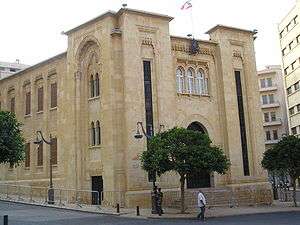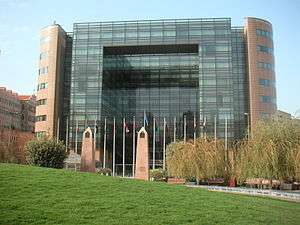Lebanese University
 | |
| Motto | Learning, Engaging and Prosperity.[1] |
|---|---|
| Type | Public University |
| Established | 1951 |
| President | Adnan Hussein |
Academic staff | 5,000 [2] |
| Students | 70,000 |
| Location | Beirut, Lebanon |
| Campus | Main Campus in Hadath, Baabda District, Urban, 705,000m²[3] |
| Website | Official website |
The Lebanese University (French: Université Libanaise, Arabic: الجامعة اللبنانية) is the only public institution for higher learning in Lebanon.[4] In 1951, notable professors and educated personalities founded, under the support of the Lebanese President Bechara El Khoury, The High House of Teachers, a class of 68 students making the first class, ever, of the Lebanese University.
The university today has 16 faculties and serves all cultural, religious, and social groups of students and teachers. The independent university enjoys administrative, academic, and financial freedom. Among its educational goals are creating a unique mix of cultures and providing the basic and necessary education to allow students to enter various professions.
History
The Lebanese University was established in 1951[5] to serve the diverse social groups that make up Lebanese society, and to provide a high-level institution in which students can acquire university degrees. It was launched amid a growth in the number of students in grades 10 to 12.
The first departments were The High House of Teachers and The Statistics Center. On 3 December 1951, the first class of 68 students entered the university, under the efforts of many professors and educated personalities, and the support of the Lebanese President Bechara El Khoury.
On 26 February 1953, official decree No. 25 founded a center for financial and administrative at the university, called The Institution of Finance and Administration. The High House of Teachers was renamed to The High Teachers Institution .
The next big change was 1959's regulating decree No. 2883, which, along with many others between 1960 and 1972, added more material into the structure of the university and legalized all of its activities, requiring students to take part as administrators within the different faculties.
-

Facade of the Beirut City Hall
-

The Grand Serail
-

Lebanese Parliament
-

United Nations Lebanon headquarters
University presidents
Following is the list of the personalities that served as Presidents of the Lebanese University:
- Fouad Ephrem al-Boustani (1953-1970)
- Edmond Naïm (1970-1976)
- Boutros Dib (1977-1980)
- Georges Tohmé (1980-1988)
- Asaad Diab (1993-2000)
- Ibrahim Kobeissi (2001-2006)
- Zuhair Shokr (2006-2011)
- Adnan Hussein (2011-present)
Faculties
The 16 faculties, including two institutions that were annexed to the university. They are:
- The Faculty of Literature and Human Sciences.
- The Faculty of Law, Political and Administrative Sciences.
- The Faculty of Sciences.
- The Faculty of Social Sciences.
- The Faculty of Fine Arts.
- The Faculty of Pedagogy (replacing the High Teachers Institution).
- The Faculty of Journalism and Documentation.
- The Faculty of Business Administration and Economical Sciences.
- The Faculty of Engineering.
- The Faculty of Agriculture.
- The Faculty of Public Health.
- The Faculty of Medicine.
- The Faculty of Dentistry.
- The Faculty of Pharmacy.
- The Faculty of Tourism and Hotels.
- The Academic Institution of Technology.
Until 1975, the physical locations of all faculties and institutions were in Beirut and its suburbs, but during 1976 and due to the Lebanese Civil War additional branches were founded in Beirut and the governorates of Mount Lebanon, North Lebanon, South Lebanon and Bekaa. The increasing difficulty of traveling within the war-torn areas due to the tense atmosphere the country was suffering from led to this decision. However, the curricula and educational content were consolidated among all branches. The Head Office and main administration bureau is in Beirut, opposite to the National Museum of Beirut.
Research
The Lebanese University offers the widest range of PhD programs in Lebanon. It has 3 doctoral schools offering various PhD programs, including PhD in Math, Physics, Biology, Chemistry, Engineering,[6] Fine Arts, Education, Literature,[7] Law, Business, Economy, and many other fields.
Libraries
The Lebanese University operates 62 libraries that are home to a collection consisting of more than 700,000 books; all the content of the libraries is accessible free of charge for the students.
Activities and Accommodations
The university provides field trips and sports activities to its students, as well as exchanging with other students locally and from outside the country. There is a library in each branch of every faculty. The students are also offered apprentice training in private and public sector. Special scholarships for pioneers are provided to continue their studies abroad. All students also enjoy health insurance by joining social insurance. Certificates and awards are given to graduates in graduation ceremonies.
Notable Alumni
- Michel Suleiman, 11th President of Lebanon
- Marcel Ghanem, Journalist
- Charbel Tayah, Francophone Novelist
- Renée Hayek, Writer and Novelist
- Antoine Ghanem, Lebanese Politician and an MP for Kataeb Party
- Jean Daoud, Poet, Playwright, Professor
- Majida El Roumi, Lebanese Singer
- Bassam Baraké
- Ezza Agha-Malak, Lebanese-born French Novelist, Poet, Critic and Essayist
- Serge Venturini, French Poet (1979-1981)
- Omar Karami, former Prime Minister of Lebanon
- Ahmed Nasri, President of Fahd bin Sultan University
- Ghada Owais, Journalist
- Rafif Sidaoui, Sociologist and University Professor
- Adnan Hussein, Political Scientist
- Mohamad Taki, Star TV
- Mohamed Ali Yousfi, Writer and Translator
References
- ↑ "Université Libanaise". ul.edu.lb. Retrieved 30 March 2014.
- ↑ "Lebanese university libraries". Lebanese university. Retrieved 30 March 2014.
- ↑ "Archinect". Aechinect. Retrieved 30 March 2014.
- ↑ Ofeish, Sami A. (1 January 1999). "Lebanon's second republic: secular talk, sectarian application". Arab Studies Quarterly. Retrieved 23 March 2013.
- ↑ Rayane Abou Jaoude (17 September 2013). "Students condemn new registration form, LU denies sectarian claims". The Daily Star. Beirut. Retrieved 16 November 2013.
- ↑ "EDST" (PDF). Ecole Doctorale Science Technique. Retrieved 8 April 2014.
- ↑ "Universite Libanaise". Universite Libanaise.
External links
- (Arabic) الموقع الرسمي
- (French) Site officiel
- (English) Official website
- On Facebook
Coordinates: 33°49′40″N 35°31′20″E / 33.827815°N 35.522189°E